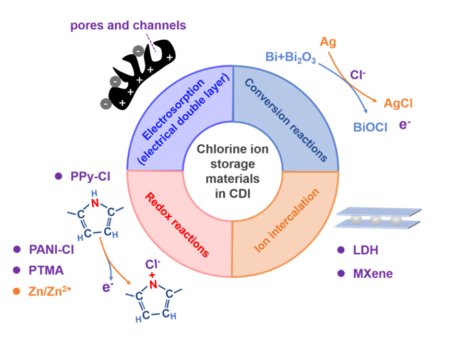Abstract: Sustainable freshwater supply is a grave challenge to the society because of the severe water scarcity and global pollution. Seawater is an inexhaustible source of industrial and potable water. The relevant desalination technologies with a high market share include reverse osmosis and thermal distillation, which are energy-intensive. Capacitive deionization (CDI) is a desalination technology that is gaining extensive attention because of its low energy consumption and low chemical intensity. In CDI, charged species are removed from the aqueous environment via applying a voltage onto the anode and cathode. For desalination, Na+ and Cl- ions are removed by the cathode and anode, respectively. With the boom in electrode materials for rechargeable batteries, the Na+ removal electrode (cathode) has evolved from a carbon-based electrode to a faradaic electrode, and the desalination performance of CDI has also been significantly enhanced. A conventional carbon-based electrode captures ions in the electrical double layer (EDL) and suffers from low charge efficiency, thus being unsuitable for use in water with high salinity. On the other hand, a faradaic electrode stores Na+ ions through a reversible redox process or intercalation, leading to high desalination capacity. However, the Cl- removal electrode (anode) has not yet seen notable development. Most research groups employ activated carbon to remove Cl-, and therefore, summarizing Cl- storage electrodes for CDI is necessary to guide the design of electrode systems with better desalination performance. First, this review outlines the evolution of CDI configuration based on the electrode materials, suggesting that the anode and cathode are of equal importance in CDI. Second, a systematic summary of the anode materials used in CDI and a comparison of the characteristics of different electrodes, including those based on Ag/AgCl, Bi/BiOCl, 2-dimensional (2D) materials (layered double hydroxide (LDH) and MXene), redox polymers, and electrolytes, are presented. Then, the underlying mechanism for Cl- storage is refined. Similar to the case of Na+ storage, traditional carbon electrodes store Cl-via electrosorption based on the EDL. Ag/AgCl and Bi/BiOCl remove Cl- through a conversion reaction, i.e., phase transformation during the reaction with Cl-. 2D materials store Cl- in the space between adjacent layers, a process referred as ion intercalation, with layered double hydroxide (LDH) and MXene showing higher Cl- storage potential. Redox polymers and electrolytes allow for Cl- storage via redox reactions. Among all the materials mentioned above, Bi/BiOCl and LDH are the most promising for the construction of CDI anodes because of their high capacity and low cost. Finally, to spur the development of novel anodes for CDI, the electrodes applied in a chlorine ion battery are introduced. This is the first paper to comb through reports on the development of anode materials for CDI, thus laying the theoretical foundation for future materials design.
Key words: Capacitive deionization, Desalination, Anode, Chlorine ion, Battery
